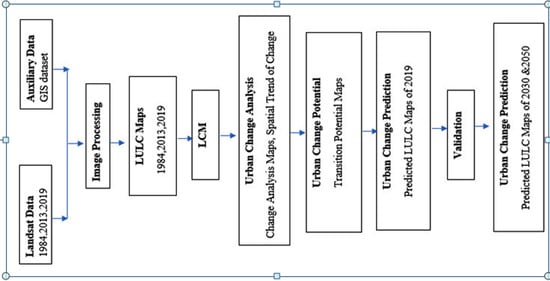Predictive Modeling of Transport Infrastructure Space for Urban Growth Phenomena in Developing Countries’ Cities: A Case Study of Kano — Nigeria
Abstract
1. Introduction
2. Materials and Methods
2.1. The Study Area
2.2. Sources of Data and Image Processing
2.3. Image Classification and Accuracy
2.4. Transition by Markov Chain Process
2.5. Cellular Automata-Markov (CA-Markov) Prediction
3. Results
3.1. Land-Use/Land-Cover (LULC) Mapping
3.2. Model Validation
- The producer accuracy (PA) of software manufacture is the ratio of samples correctly classified LULC pixels in the same class to the row total of pixel samples in that class. It is an omission error between observed features in the ground reference missing in classified image, i.e., PA = (100 − error of omission)%.
- The user accuracy (UA) is the ratio of samples correctly classified LULC pixels in the same class to the column total of pixel samples in that class. It is a commission error of the wrong classification types between classified and ground images, i.e., UA = (100%—error of commission)%.
- Overall accuracy (OA) is the total pixel of correctly classified samples in the diagonal cell diagonal matrix divided by the overall pixel total sample.
- Kappa index of agreement () provides check for accuracy of classification between remote sensing classified images and referenced ground maps.
3.3. Model Application
3.3.1. The Initial State
3.3.2. The Transition State Probability Matrix
4. Discussion
4.1. LULC Maps
4.2. Markov Land-Use Prediction
4.3. Transition Suitability Maps
5. Conclusions
Author Contributions
Funding
Institutional Review Board Statement
Informed Consent Statement
Data Availability Statement
Acknowledgments
Conflicts of Interest
References
- Satterthwaite, D.; McGranahan, G.; Tacoli, C. Urbanization and its implications for food and farming. Philos. Trans. R. Soc. B Biol. Sci. 2010, 365, 2809–2820. [Google Scholar] [CrossRef]
- Rimal, B.; Zhang, L.; Stork, N.E.; Sloan, S.; Rijal, S. Urban Expansion Occurred at the Expense of Agricultural Lands in the Tarai Region of Nepal from 1989 to 2016. Sustainability 2018, 10, 1341. [Google Scholar] [CrossRef]
- Singh, S.K.; Srivastava, P.K.; Szabó, S.; Petropoulos, G.P.; Gupta, M.; Islam, T. Landscape transform and spatial metrics for mapping spatiotemporal land cover dynamics using Earth Observation data-sets. Geocarto. Int. 2016, 32, 1–15. [Google Scholar] [CrossRef]
- EEA. Transport Greenhouse Gas Emissions: The Seventh Environment Action Programme (7th EAP). EEA Environmental Indicator Report 2018, Coppenhagen, Denmark. 2018. Available online: https://www.eea.europa.eu/airs/2018/resource-efficiency-and-low-carbon-economy/transport-ghg-emissions (accessed on 2 August 2020).
- Asamoah, E.F.; Zhang, L.; Liu, G.; Owusu-Prempeh, N.; Rukundo, E. Estimating the “Forgone” ESVs for Small-Scale Gold Mining Using Historical Image Data. Sustainability 2017, 9, 1976. [Google Scholar] [CrossRef]
- Basommi, L.P.; Guan, Q.; Cheng, D.; Singh, S.K. Dynamics of land use change in a mining area: A case study of Nadowli District, Ghana. J. Mt. Sci. 2016, 13, 633–642. [Google Scholar] [CrossRef]
- Duraisamy, V.; Bendapudi, R.; Jadhav, A. Identifying hotspots in land use land cover change and the drivers in a semi-arid region of India. Environ. Monit. Assess. 2018, 190, 1–21. [Google Scholar] [CrossRef]
- Ejaro, S.P.; Abdullahi, U. Spatiotemporal analyses of land use and land cover changes in Suleja Local Government Area, Niger State, Nigeria. J. Environ. Earth Sci. 2013, 3, 72–83. [Google Scholar]
- Hassan, Z.; Shabbir, R.; Ahmad, S.S.; Malik, A.H.; Aziz, N.; Butt, A.; Erum, S. Dynamics of land use and land cover change (LULCC) using geospatial techniques: A case study of Islamabad Pakistan. SpringerPlus 2016, 5, 1–11. [Google Scholar] [CrossRef]
- Khan, S.; Qasim, S.; Ambreen, R.; Syed, Z.-U.-H. Spatio-Temporal Analysis of Landuse/Landcover Change of District Pishin Using Satellite Imagery and GIS. J. Geogr. Inf. Syst. 2016, 8, 361–368. [Google Scholar] [CrossRef]
- Okoli, I.E.; Okoro, C.B.; Adekitan, R.A. The economic effect of urbanization to sustainable food production and development. Int. J. Sch. Res. 2016, 11, 50–62. [Google Scholar]
- Weng, Q. A remote sensing? GIS evaluation of urban expansion and its impact on surface temperature in the Zhujiang Delta, China. Int. J. Remote Sens. 2001, 22, 1999–2014. [Google Scholar] [CrossRef]
- Barredo, J.I.; Demicheli, L.; LaValle, C.; Kasanko, M.; McCormick, N. Modelling Future Urban Scenarios in Developing Countries: An Application Case Study in Lagos, Nigeria. Environ. Plan. B Plan. Des. 2004, 31, 65–84. [Google Scholar] [CrossRef]
- Mundia, C.N.; Aniya, M. Dynamics of landuse/cover changes and degradation of Nairobi City, Kenya. Land Degrad. Dev. 2006, 17, 97–108. [Google Scholar] [CrossRef]
- Prasad, V.K.; Stinner, B.; Stinner, D.; Cardina, J.; Moore, R.; Gupta, P.K.; Tsuruta, H.; Tanabe, K.; Badarinath, K.V.S.; Hoy, C. Trends in food production and nitrous oxide emissions from the agriculture sector in India: Environmental implications. Reg. Environ. Chang. 2003, 3, 154–161. [Google Scholar] [CrossRef]
- Farrell, K. An Inquiry into the Nature and Causes of Nigeria’s Rapid Urban Transition. Urban Forum 2018, 29, 277–298. [Google Scholar] [CrossRef]
- Jiboye, A.D. Sustainable Urbanization: Issues and Challenges for Effective Urban Governance in Nigeria. J. Sustain. Dev. 2011, 4, 211. [Google Scholar] [CrossRef]
- Ujoh, F.; Kwabe, I.D.; Ifatimehin, O. Understanding urban sprawl in the Federal Capital City, Abuja: Towards sustainable urbanization in Nigeria. J. Geogr. Reg. Plan. 2010, 2, 106–113. [Google Scholar]
- Fox, S.; Bloch, R.; Monroy, J. Understanding the Dynamics of Nigeria’s Urban Transition: A Refutation of the ’Stalled Urbanisation’ Hypothesis. Urban Stud. 2018, 55, 947–964. [Google Scholar] [CrossRef]
- Mukhtar, S. Land use land cover change detection through remote sensing approach in Kano State Nigeria. Pyrex J. Geogr. Reg. Plan. 2016, 2, 16–28. [Google Scholar]
- Suleiman, M.S.; Wasonga, O.V.; Mbau, J.S.; Elhadi, Y.A. Spatial and temporal analysis of forest cover change in Falgore Game Reserve in Kano, Nigeria. Ecol. Process. 2017, 6, 11. [Google Scholar] [CrossRef]
- Jianping, L.; Bai, Z.; Feng, G. RS-and-GIS-supported forecast of grassland degradation in southwest Songnen plain by Markov model. Geo-Spatial Inf. Sci. 2005, 8, 104–109. [Google Scholar] [CrossRef]
- Zhang, Y.; Odeh, I.O.; Ramadan, E. Assessment of land surface temperature in relation to landscape metrics and fractional vegetation cover in an urban/peri-urban region using Landsat data. Int. J. Remote Sens. 2012, 34, 168–189. [Google Scholar] [CrossRef]
- García-Mora, B.; Santamaría, C.; Navarro, E.; Rubio, G. Modeling bladder cancer using a Markov process with multiple absorbing states. Math. Comput. Model. 2010, 52, 977–982. [Google Scholar] [CrossRef]
- Munthali, M.; Mustak, S.; Adeola, A.; Botai, J.; Singh, S.; Davis, N. Modelling land use and land cover dynamics of Dedza district of Malawi using hybrid Cellular Automata and Markov model. Remote Sens. Appl. Soc. Environ. 2020, 17, 100276. [Google Scholar] [CrossRef]
- Beall, J.; Guha-Khasnobis, B.; Kanbur, R. Introduction: African Development in an Urban World: Beyond the Tipping Point. Urban Forum 2010, 21, 187–204. [Google Scholar] [CrossRef]
- United Nations. World Urbanization Prospects 2018: Highlights (ST/ESA/SER.A/421). United Nations Department of Economic and Social Affairs Population Division (UN DESA-PD). 2019. Available online: https://population.un.org/wup/Publications/Files/WUP2018-Highlights.pdf (accessed on 15 April 2019).
- Turok, I.; McGranahan, G. Urbanization and economic growth: The arguments and evidence for Africa and Asia. Environ. Urban. 2013, 25, 465–482. [Google Scholar] [CrossRef]
- Angel, S.; Parent, J.; Civco, D.L. The fragmentation of urban landscapes: Global evidence of a key attribute of the spatial structure of cities, 1990–2000. Environ. Urban. 2012, 24, 249–283. [Google Scholar] [CrossRef]
- Jāhāna, S. Human Development Report 2016: Human Development for Everyone; United Nations Development Programme: New York, NY, USA, 2016; Available online: http://hdr.undp.org/en/2016-report (accessed on 15 February 2020).
- Wang, S.; Zheng, X.; Zang, X. Accuracy assessments of land use change simulation based on Markov-cellular automata model. Procedia Environ. Sci. 2012, 13, 1238–1245. [Google Scholar] [CrossRef]
- Chander, G.; Markham, B.L.; Helder, D.L. Summary of current radiometric calibration coefficients for Landsat MSS, TM, ETM+, and EO-1 ALI sensors. Remote Sens. Environ. 2009, 113, 893–903. [Google Scholar] [CrossRef]
- Zhu, Z. Change detection using landsat time series: A review of frequencies, preprocessing, algorithms, and applications. ISPRS J. Photogramm. Remote Sens. 2017, 130, 370–384. [Google Scholar] [CrossRef]
- Ibrahim, A.M.; Mohammed, M.A. Road network: The silent treasures of Kano metropolis. Bayero J. Pure Appl. Sci. 2016, 9, 87. [Google Scholar] [CrossRef]
- Kibon, U.A.; Ahmed, M. Distribution of Primary Health Care Facilities in Kano Metropolis Using GIS (Geographic Information System). Res. J. Environ. Earth Sci. 2013, 5, 167–176. [Google Scholar] [CrossRef]
- Fonseca, L.M.G.; Costa, M.H.M. Automatic registration of satellite images. In Proceedings of the X Brazilian Symposium on Computer Graphics and Image Processing, Campos do Jordao, Brazil, 14–17 October 1997; pp. 219–226. [Google Scholar]
- Lamine, S.; Petropoulos, G.P.; Singh, S.K.; Szabó, S.; Bachari, N.E.; Srivastava, P.K.; Suman, S. Quantifying land use/land cover spatio-temporal landscape pattern dynamics from Hyperion using SVMs classifier and FRAGSTATS®. Geocarto Int. 2018, 33, 862–878. [Google Scholar] [CrossRef]
- Halmy, M.W.A.; Gessler, P.E.; Hicke, J.A.; Salem, B.B. Land use/land cover change detection and prediction in the north-western coastal desert of Egypt using Markov-CA. Appl. Geogr. 2015, 63, 101–112. [Google Scholar] [CrossRef]
- Srivastava, P.K.; Han, D.; Rico-Ramirez, M.A.; Bray, M.; Islam, T. Selection of classification techniques for land use/land cover change investigation. Adv. Space Res. 2012, 50, 1250–1265. [Google Scholar] [CrossRef]
- Hadi, S.J.; Shafri, H.Z.M.; Mahir, M.D. Modelling LULC for the period 2010–2030 using GIS and Remote sensing: A case study of Tikrit, Iraq. In Proceedings of the IOP Conference Series: Earth and Environmental Science, 7th IGRSM International Remote Sensing & GIS Conference and Exhibition, Kuala Lumpur, Malaysia, 22–23 April 2014; Volume 20, p. 012053. [Google Scholar]
- Lambin, E.; Rounsevell, M.; Geist, H. Are agricultural land-use models able to predict changes in land-use intensity? Agric. Ecosyst. Environ. 2000, 82, 321–331. [Google Scholar] [CrossRef]
- Omar, N.Q.; Sanusi, S.; Hussin, W.M.W.; Samat, N.; Mohammed, K. Markov-CA model using analytical hierarchy process and multiregression technique. In Proceedings of the IOP Conference Series: Earth and Environmental Science, 7th IGRSM International Remote Sensing & GIS Conference and Exhibition, Kuala Lumpur, Malaysia, 22–23 April 2014; Volume 20, p. 012008. [Google Scholar]
- Raj, P. Evaluation of Different Techniques to Detect Land Use/Land Cover Change Over an Area. Ph.D. Thesis, Department of Civil Engineering, NIT Rourkela, Odisha, India, 2017. [Google Scholar]
- Talukdar, S.; Singha, P.; Mahato, S.; Pal, S.; Liou, Y.A.; Rahman, A. Land-Use Land-Cover Classification by Machine Learning Classifiers for Satellite Observations—A Review. Remote Sens. 2020, 12, 1135. [Google Scholar] [CrossRef]
- Mahmud, A.; Achide, A.S. Analysis of land use/land cover changes to monitor urban sprawl in Keffi-Nigeria. Environ. Res. J. 2012, 6, 130–135. [Google Scholar]
- Jensen, J.R.; Lulla, K. Introductory digital image processing: A remote sensing perspective. Geocarto Int. 1987, 2, 65. [Google Scholar] [CrossRef]
- Behera, M.D.; Borate, S.N.; Panda, S.N.; Behera, P.R.; Roy, P.S. Modelling and analyzing the watershed dynamics using Cellular Automata (CA)—Markov model—A geo-information-based approach. J. Earth Syst. Sci. 2012, 121, 1011–1024. [Google Scholar] [CrossRef]
- Li, S.T.; Cheng, Y.C. A Hidden Markov Model-Based Forecasting Model for Fuzzy Time Series; WSEAS: Stevens Point, WI, USA, 2006; Volume 5, pp. 1919–1924. [Google Scholar] [CrossRef]
- Zhang, R.; Tang, C.; Ma, S.; Yuan, H.; Gao, L.; Fan, W. Using Markov chains to analyze changes in wetland trends in arid Yinchuan Plain, China. Math. Comput. Model. 2011, 54, 924–930. [Google Scholar] [CrossRef]
- Adepoju, K.A.; Adelabu, S.; Fashae, O. Vegetation Response to Recent Trends in Climate and Landuse Dynamics in a Typical Humid and Dry Tropical Region under Global Change. Adv. Meteorol. 2019, 2019, 1–15. [Google Scholar] [CrossRef]
- Ibrahim, Y.Z.; Balzter, H.; Kaduk, J. Land degradation continues despite greening in the Nigeria-Niger border region. Glob. Ecol. Conserv. 2018, 16, e00505. [Google Scholar] [CrossRef]
- Nwaogu, C.; Okeke, O.J.; Fadipe, O.O.; Bashiru, K.A.; Pechanec, V. Is Nigeria losing its natural vegetation and landscape? Assessing the landuse-landcover change trajectories and effects in Onitsha using remote sensing and GIS. Open Geosci. 2017, 9, 707–718. [Google Scholar] [CrossRef]
- Liping, C.; YuJun, S.; Saeed, S. Monitoring and predicting land use and land cover changes using remote sensing and GIS techniques—A case study of a hilly area, Jiangle, China. PLoS ONE 2018, 13, e0200493. [Google Scholar] [CrossRef] [PubMed]
- Madugu, Y.U. Filling the mobility gaps: The shared taxi industry in Kano, Nigeria. J. Transp. Hist. 2018, 39, 41–54. [Google Scholar] [CrossRef]
- Onatere, J.O.; Nwagboso, C.; Georgakis, P. Performance indicators for urban transport development in Nigeria. WIT Trans. Built Environ. 2014, 138, 14. [Google Scholar] [CrossRef]
- Ojo, A.; Papachristodoulou, N.; Ibeh, S. The Development of an Infrastructure Quality Index for Nigerian Metropolitan Areas Using Multivariate Geo-Statistical Data Fusion. Urban Sci. 2018, 2, 59. [Google Scholar] [CrossRef]
- El-Hallaq, M.A.; Habboub, M.O. Using GIS for Time Series Analysis of the Dead Sea from Remotely Sensing Data. Open J. Civ. Eng. 2014, 4, 386–396. [Google Scholar] [CrossRef]
- Mishra, V.N.; Rai, P.K. A remote sensing aided multi-layer perceptron-Markov chain analysis for land use and land cover change prediction in Patna district (Bihar), India. Arab. J. Geosci. 2016, 9, 1–18. [Google Scholar] [CrossRef]
- Onolememen, M.O. The Impact of Leadership on the Governance of Infrastructure Development in Nigeria. Ph.D. Thesis, Walden University, Washington, WA, USA, 2015. [Google Scholar]
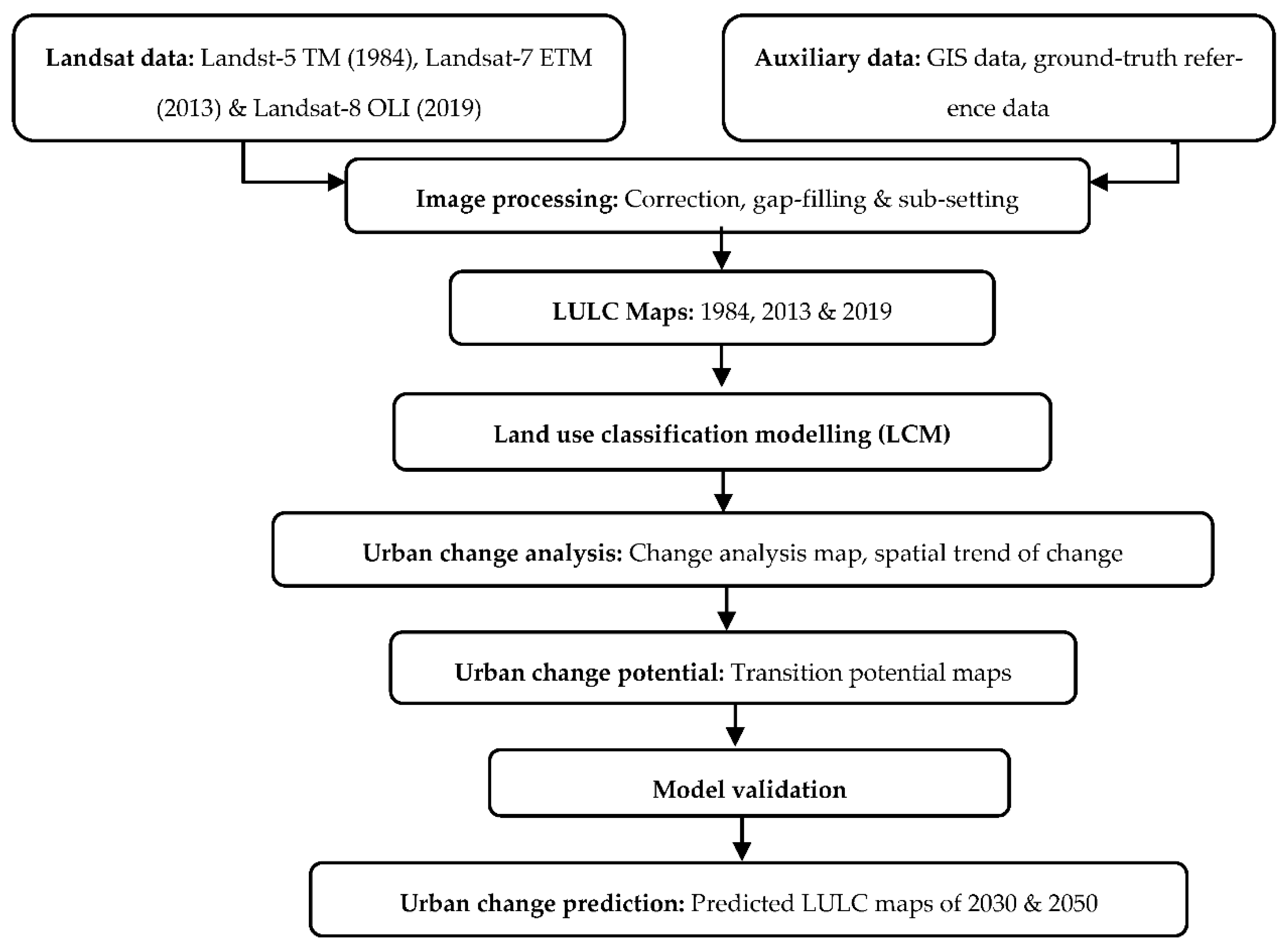
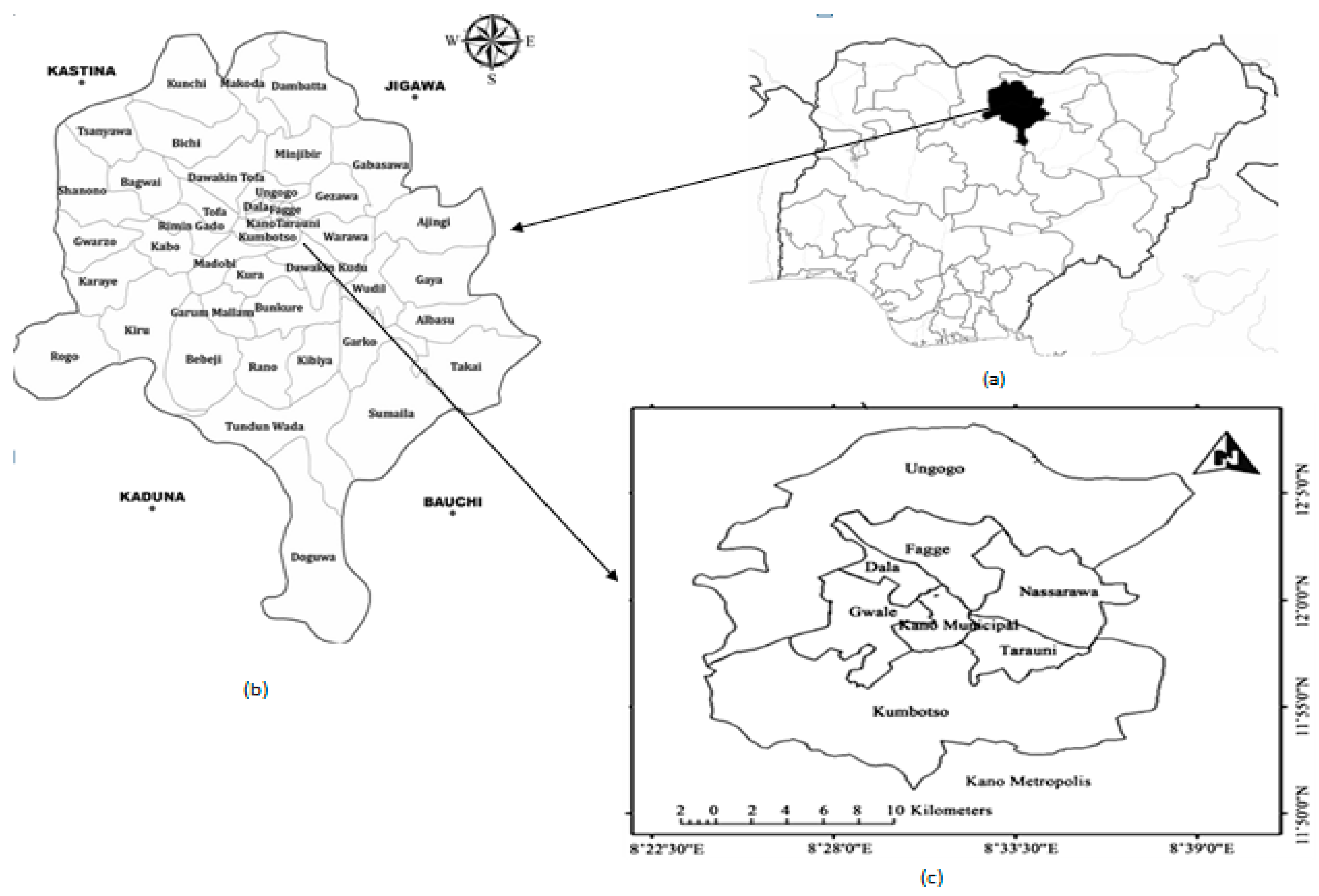



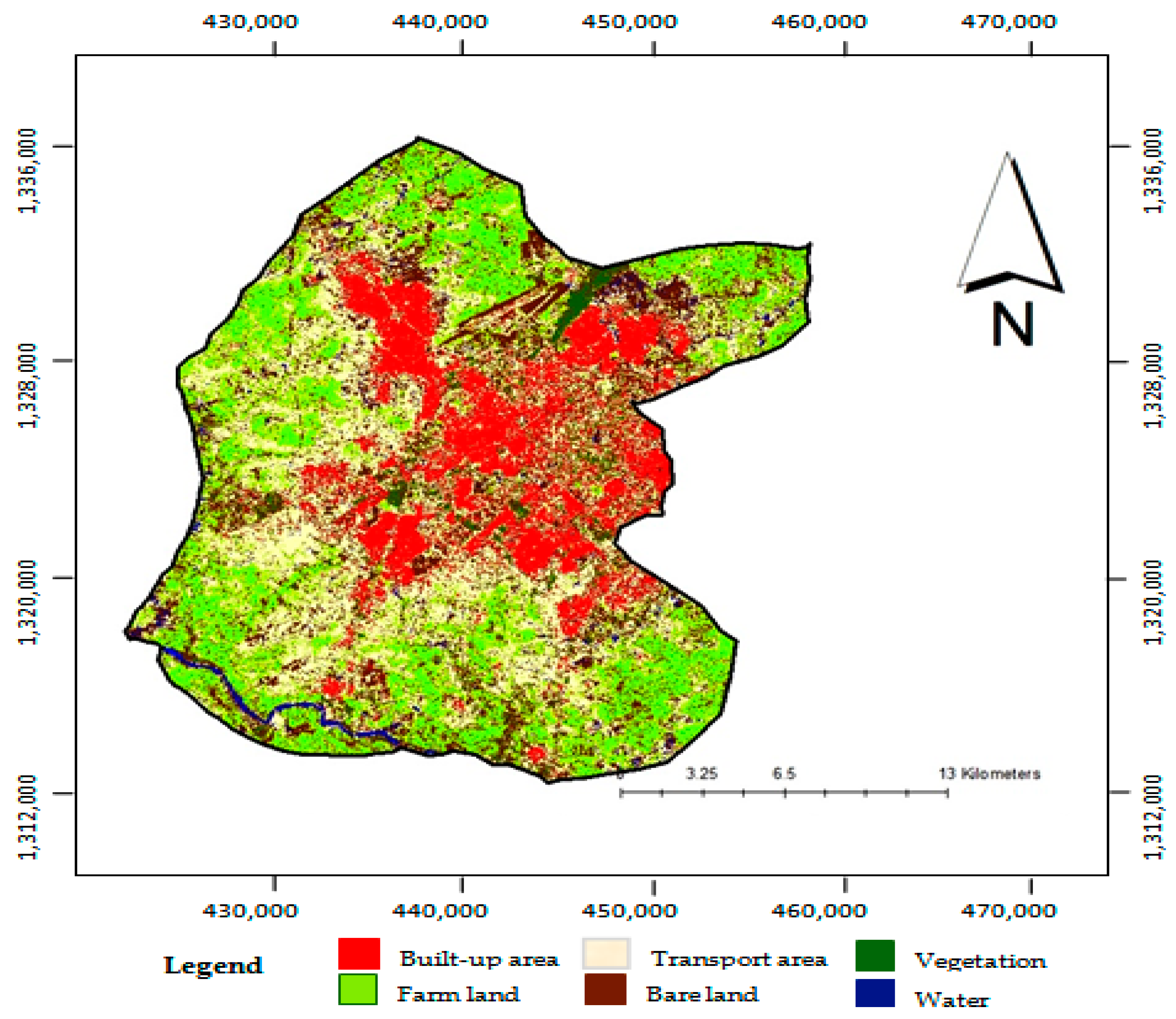
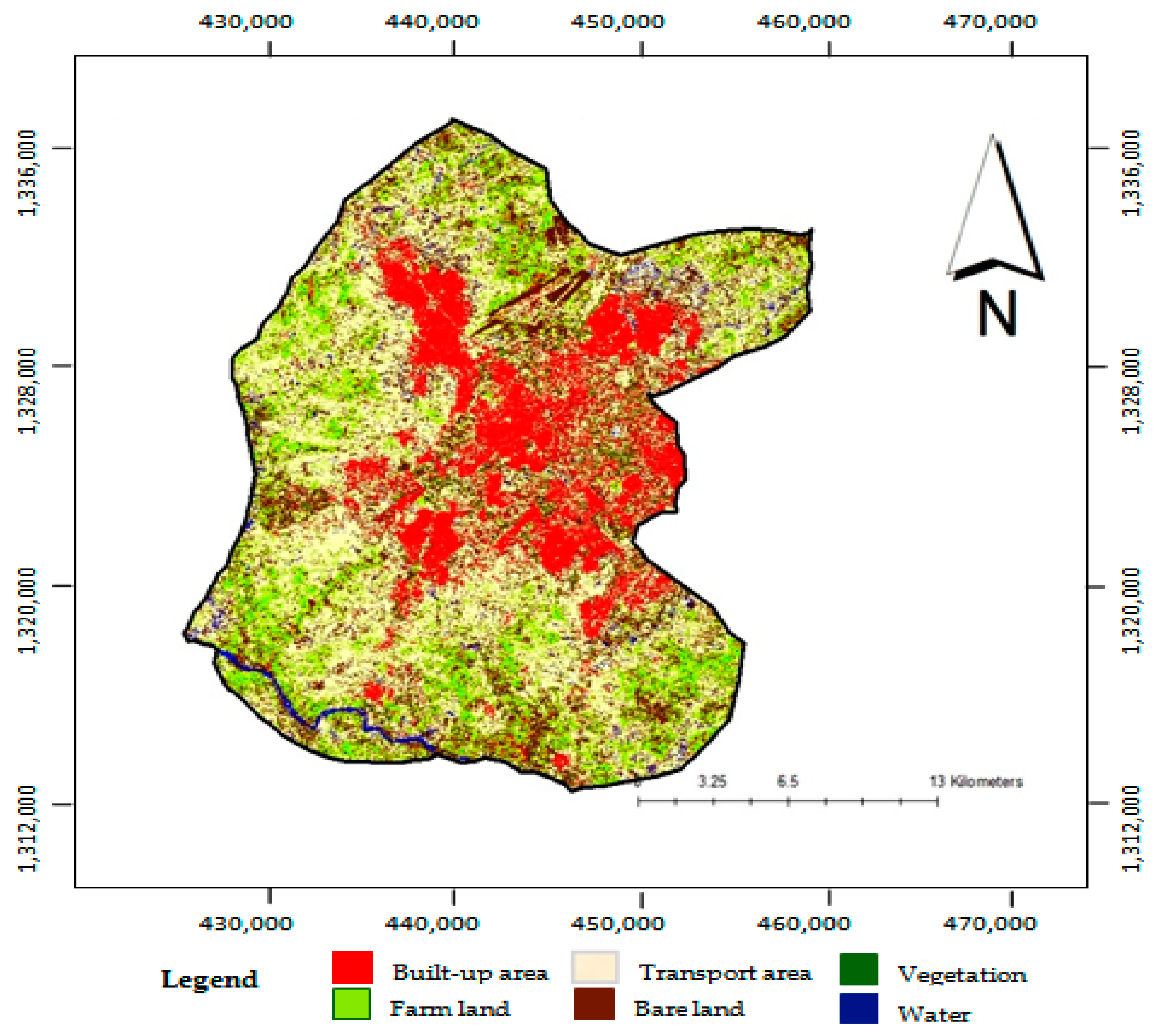
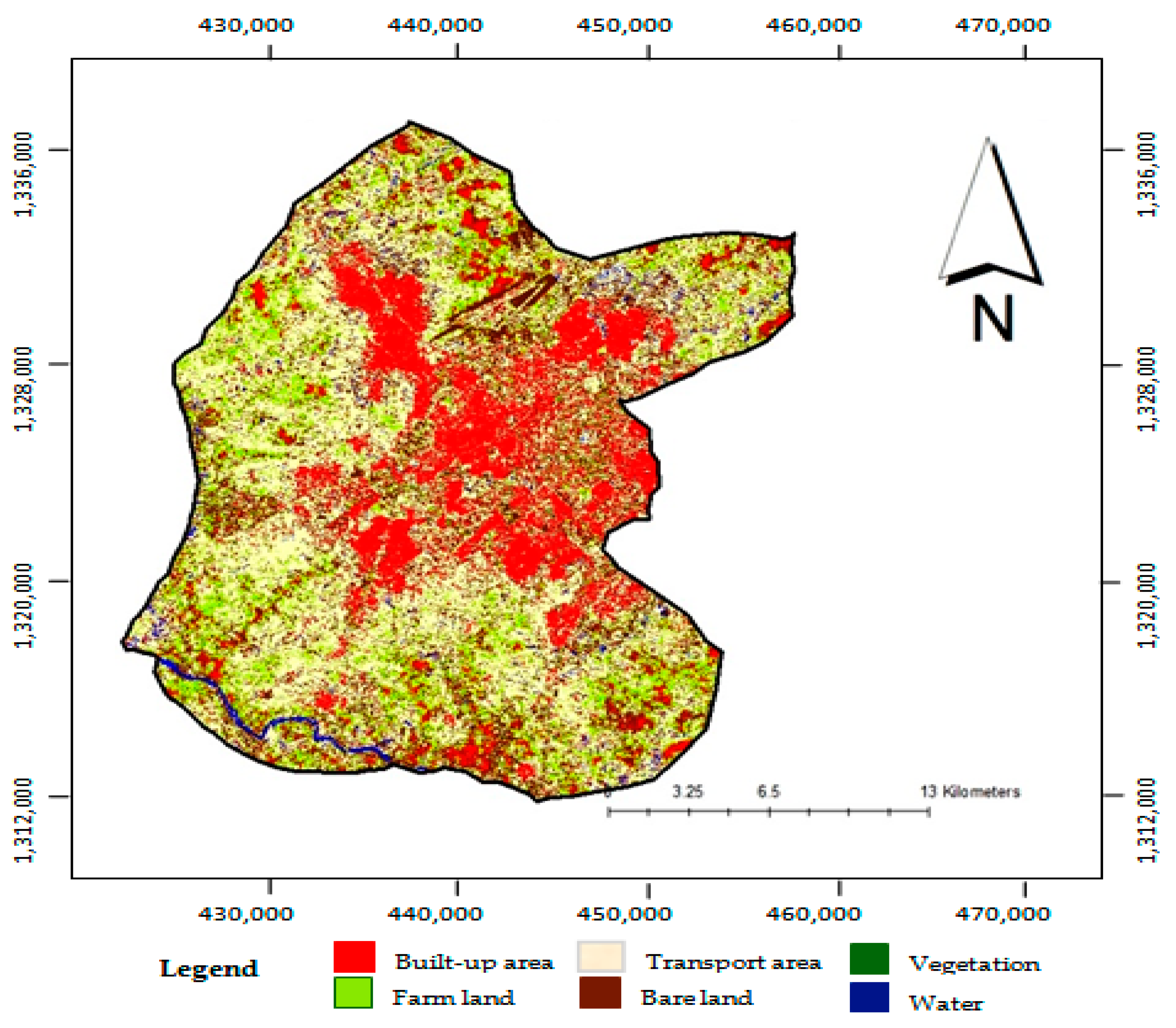

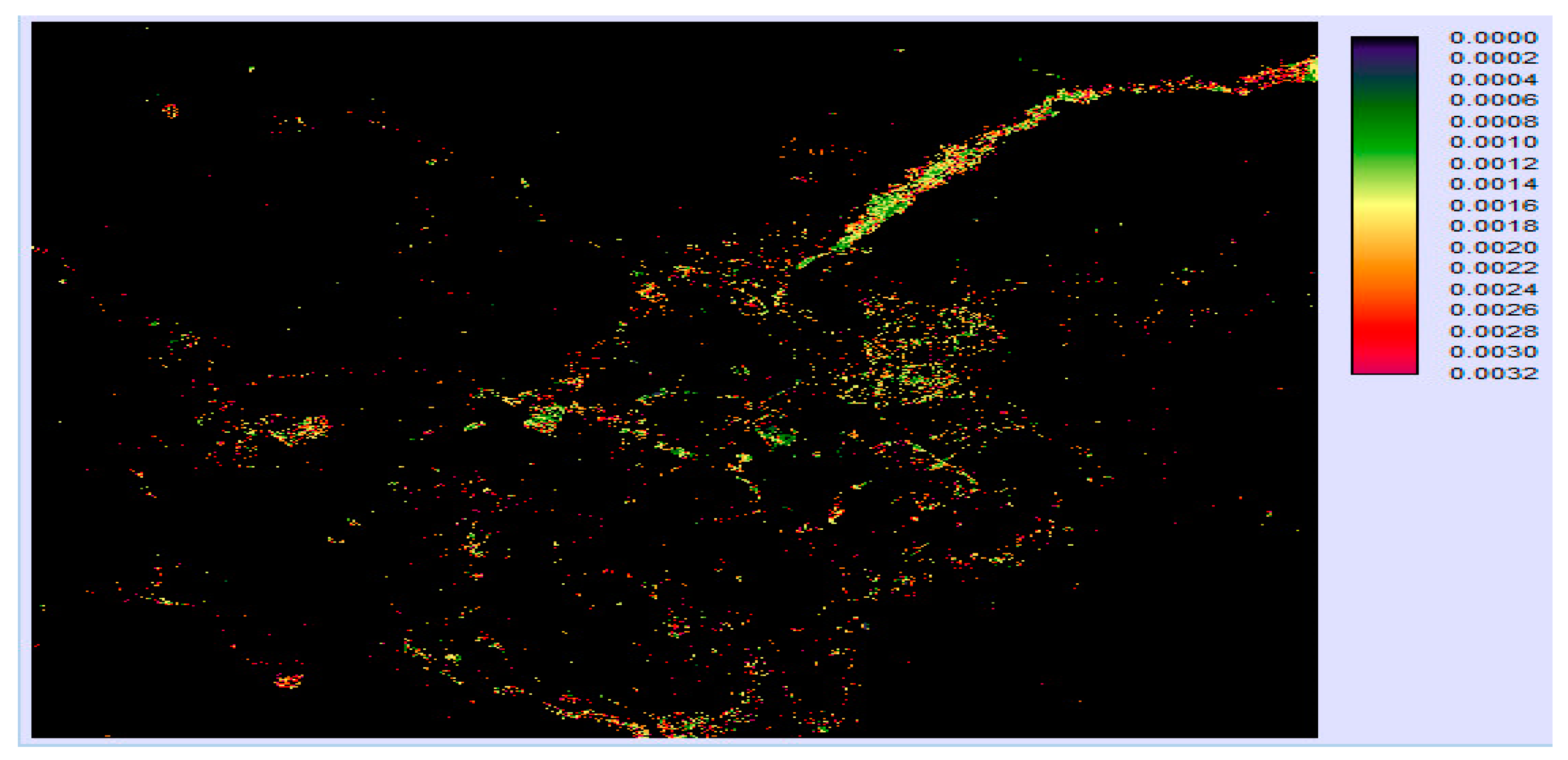
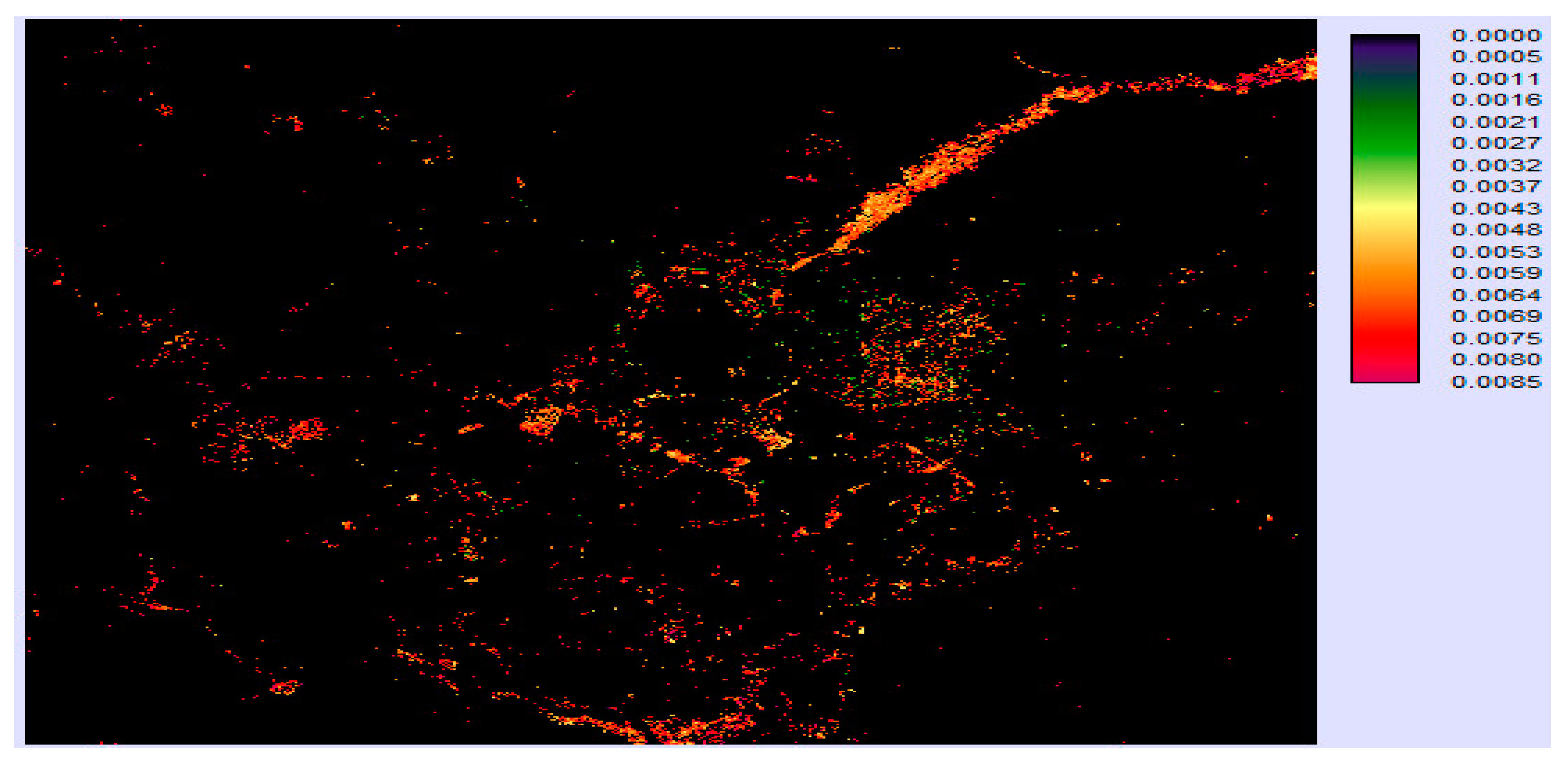
| Imagery Date | Sensor | Satellite | Path | Rows | Spatial Resolution (m) | Spectra Bands |
|---|---|---|---|---|---|---|
| 25/07/1984 | TM | Landsat 5 | 191 | 055, 056 | 30 | 7 |
| 15/03/2013 | ETM+ | Landsat 7 | 191 | 055, 056 | 30 | 7 |
| 02/10/2019 | OLI | Landsat 8 | 191 | 055, 056 | 30 | 8 |
| Year LULC Types | 1984 | 2013 | 2019 | |||
|---|---|---|---|---|---|---|
| Area (km2) | Percent | Area (km2) | Percent | Area (km2) | Percent | |
| Transport infrastructure | 137 | 17.6 | 234 | 31.0 | 290 | 34.9 |
| Built up areas | 29 | 3.7 | 86 | 11.1 | 111 | 16.3 |
| Farmland | 355 | 45.3 | 274 | 36.3 | 261 | 31.3 |
| Bare land | 210 | 26.7 | 154 | 20.4 | 150 | 18.0 |
| Vegetation | 17 | 2.3 | 15.5 | 2.1 | 14 | 1.7 |
| Water | 34 | 4.3 | 21.1 | 2.7 | 09 | 1.0 |
| Total | 782 | 100 | 784.6 | 100 | 835 | 100 |
| Land Use Types | 1984 | 2013 | 2019 | |||
|---|---|---|---|---|---|---|
| UA (%) | PA (%) | UA (%) | UA (%) | PA (%) | UA (%) | |
| Transport land | 89 | 88 | 86 | 84 | 88 | 93 |
| Built-up areas | 84 | 78 | 76 | 81 | 89 | 82 |
| Farmland | 78 | 82 | 84 | 82 | 85 | 86 |
| Vegetation | 89 | 84 | 86 | 83 | 84 | 90 |
| Bare land | 88 | 92 | 94 | 92 | 96 | 94 |
| Water | 87 | 79 | 84 | 86 | 87 | 95 |
| Overall accuracy (%) | 86 | 89 | 90 | |||
| Kappa coefficient (%) | 85 | 86 | 88 | |||
| From 1984: | To 2013: | ||||||
|---|---|---|---|---|---|---|---|
| Transport Land | Built-Up Area | Farmland | Bare Land | Vegetation | Water | Area Total | |
| Transport land | 83.5837 | 17.1113 | 11.9738 | 18.4813 | 5.8499 | 0.0000 | 137 |
| Built-up areas | 6.8382 | 22.1618 | 0.0000 | 0.0000 | 0.0000 | 0.0000 | 29 |
| Farmland | 56.1965 | 0.0000 | 272.4270 | 16.3655 | 0.0000 | 10.0110 | 355 |
| Bare land | 44.3520 | 42.8400 | 35.5740 | 87.2340 | 0.0000 | 0.0000 | 210 |
| Vegetation | 3.1637 | 5.1527 | 0.0000 | 0.0000 | 8.6836 | 0.0000 | 17 |
| Water | 0.0000 | 0.0000 | 8.7244 | 7.2794 | 0.2176 | 17.7786 | 34 |
| From 1984: | To 2013: | |||||
|---|---|---|---|---|---|---|
| Transport Land | Built-Up Area | Farmland | Bare Land | Vegetation | Water | |
| Transport land | 0.6101 | 0.1249 | 0.0874 | 0.1349 | 0.0427 | 0.0000 |
| Built up areas | 0.2358 | 0.7642 | 0.0000 | 0.0000 | 0.0000 | 0.0000 |
| Farmland | 0.1583 | 0.0000 | 0.7674 | 0.0461 | 0.0000 | 0.0282 |
| Bare land | 0.2112 | 0.2040 | 0.1694 | 0.4154 | 0.0000 | 0.0000 |
| Vegetation | 0.1861 | 0.3031 | 0.0000 | 0.0000 | 0.5108 | 0.0000 |
| Water | 0.0000 | 0.0000 | 0.2566 | 0.2141 | 0.0064 | 0.5229 |
| From 2013: | To 2019: | |||||
|---|---|---|---|---|---|---|
| Transport Land | Built-Up Area | Farmland | Bare Land | Vegetation | Water | |
| Transport land | 0.6504 | 0.1543 | 0.0151 | 0.0332 | 0.0336 | 0.1134 |
| Built up areas | 0.1732 | 0.8268 | 0.0000 | 0.0000 | 0.0000 | 0.0000 |
| Farmland | 0.2025 | 0.0000 | 0.6897 | 0.0698 | 0.0097 | 0.0283 |
| Bare land | 0.2477 | 0.0164 | 0.2137 | 0.5222 | 0.0000 | 0.0000 |
| Vegetation | 0.1439 | 0.2412 | 0.0000 | 0.0000 | 0.6049 | 0.0000 |
| Water | 0.0138 | 0.0335 | 0.2714 | 0.0016 | 0.0000 | 0.6797 |
| Land Use Types | 2030 | 2050 | Change: 2019–2030 | Change: 2030–2050 | ||||
|---|---|---|---|---|---|---|---|---|
| Area | (%) | Area | (%) | Area | (%) | Area | (%) | |
| Transport land | 345 | 38.6 | 410 | 42.4 | 55 | 3.90 | 120 | 11.7 |
| Built-up area | 140 | 15.6 | 155 | 16.0 | 29 | 2.40 | 44 | 2.8 |
| Farmland | 250 | 27.9 | 248 | 25.7 | −11 | −3.30 | −13 | −5.5 |
| Bare land | 139 | 15.5 | 135 | 14 | −20 | −2.40 | −24 | −3.9 |
| Vegetation | 13 | 1.5 | 12 | 1.2 | −1 | −0.17 | −2 | −0.5 |
| Water | 8 | 0.89 | 7 | 0.72 | −1 | 0.11 | −2 | −0.3 |
| Total | 895 | 100 | 967 | 100 | − | − | − | − |
Publisher’s Note: MDPI stays neutral with regard to jurisdictional claims in published maps and institutional affiliations. |
© 2020 by the authors. Licensee MDPI, Basel, Switzerland. This article is an open access article distributed under the terms and conditions of the Creative Commons Attribution (CC BY) license (http://creativecommons.org/licenses/by/4.0/).
Share and Cite
Otuoze, S.H.; Hunt, D.V.L.; Jefferson, I. Predictive Modeling of Transport Infrastructure Space for Urban Growth Phenomena in Developing Countries’ Cities: A Case Study of Kano — Nigeria. Sustainability 2021, 13, 308. https://doi.org/10.3390/su13010308
Otuoze SH, Hunt DVL, Jefferson I. Predictive Modeling of Transport Infrastructure Space for Urban Growth Phenomena in Developing Countries’ Cities: A Case Study of Kano — Nigeria. Sustainability. 2021; 13(1):308. https://doi.org/10.3390/su13010308
Chicago/Turabian StyleOtuoze, Suleiman Hassan, Dexter V. L. Hunt, and Ian Jefferson. 2021. "Predictive Modeling of Transport Infrastructure Space for Urban Growth Phenomena in Developing Countries’ Cities: A Case Study of Kano — Nigeria" Sustainability 13, no. 1: 308. https://doi.org/10.3390/su13010308
APA StyleOtuoze, S. H., Hunt, D. V. L., & Jefferson, I. (2021). Predictive Modeling of Transport Infrastructure Space for Urban Growth Phenomena in Developing Countries’ Cities: A Case Study of Kano — Nigeria. Sustainability, 13(1), 308. https://doi.org/10.3390/su13010308






